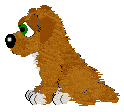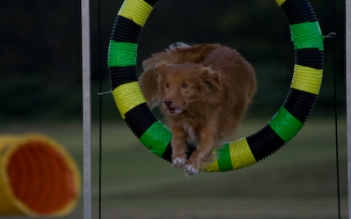

|
The Nova Scotia Duck Tolling Retriever, commonly called a "Toller", is one of the breeds in the Gundog family. Originally called the Little River Duck Dog, it was bred to lure waterfowl. The breed was officially recognised by the Canadian Kennel Club in 1945, and the Australian Kennel Club in 1991. Tollers are unusual amongst the other retriever breeds, in that they are bred for a unique purpose. Unlike most retrievers, with a Toller, the hunter hides in the blind, and the Toller goes out to play by the water. Ducks and other waterfowl (not being the brightest of creatures), see the activity and come over to have investigate. The hunter then gets a close range shot, with the dog then retrieving the down birds. Nowadays, Tollers are still popular amongst hunters for these unique traits. Tollers are the smallest of the retrieving breeds, with a foxy red or orange coat. They have a heavily feathered tail, usually carried high when they are excited. They can have white markings on their feet, chest, a blaze on their face and the tip of their tail. Tollers will shed their coats, usually once or twice a year. A good brushing weekly and the occasional bath will keep them looking clean. They are extremely alert and intelligent, and always ready for action, with a definite streak of mischief! They should never be aggressive or nervous, and they get along with other dogs. Tollers make excellent family dogs, being very loyal to their family, and are kindly and patient with children. They have a lot of energy, and will retrieve toys for hours if given the opportunity (and a willing thrower!). Whilst happy to be alone during the day, they do expect to be treated as a member of the "pack" and want to be with their family when they are home, usually content to curl up nearby, or even on any convenient lap! Tollers are extremely intelligent, and early obedience training is a must, to teach basic manners. Being such a clever dog, a bored Toller is not a happy Toller and a daily walk around the block is generally not enough to keep them challenged. Ongoing training, or being active in a dog sport such as agility will help keep all of those Toller smarts channelled into appropriate activities. |

Breed Standard
|
Origin and Purpose |
The Nova Scotia Duck Tolling Retriever was
developed in |
|
General Appearance |
The toller is a medium-sized, powerful, compact, balanced, well-muscled dog; medium to heavy in bone, with a high degree of agility, alertness, and determination. Many Tollers have a slightly sad expression until they go to work, when their aspect changes to intense concentration and excitement. At work, the dog has a speedy, rushing action, with the head carried out almost level with the back and heavily-feathered tail in constant motion. |
|
Temperament |
The Toller is highly intelligent, easy to train, and has great endurance. A strong and able swimmer, he is a natural and tenacious retriever on land and from water, setting himself for springy action the moment the slightest indication is given that retrieving is required. His strong retrieving desire and playfulness are qualities highly essential to his tolling ability. |
|
Size |
Ideal height for males over 18 months is 19-20 inches (48-51 cm); females over 18 months 18-19 inches (45-48 cm). One ince (3cm) over or under ideal height is allowed. Weight should be in proportion to the height and bone of the dog - guidelines; 45-51lb (20-23kg) for adult males; bitches 37-43lb (17-20kg). |
|
Coat and Colour |
The Toller was bred to retrieve from icy waters and must have a water-repellent double coat of medium length and softness with a softer, dense undercoat. The coat may have a slight wave on the back but is otherwise straight. Some winter coats may form a long, loose curl at the throat. Featherings are soft at the throat, behind the ears and at the back of the thighs, and forelegs are moderately feathered. Colour is various shades of red or orange with lighter featherings and underside of tail, and usually at least one of the following white markings - tip of tail, feet (not exceeding beyond the pasterns), chest, and blaze. A dog of otherwise high quality is not to be penalised for lack of white. The pigment of the nose, lips and eye rims to be flesh coloured, blending with coat, or black. |
|
Head |
Skull: The head is clean-cut and slightly wedge-shaped. The broad skull is only slightly rounded, the occiput not prominent and the cheeks flat. A good measurement for an average male would be 5 1/2 inches (14 cm) between the ears, tapering to 1 1/2 inches (3.8 cm) at the bridge of the nose. Length of head is approximately 9 inches (23cms) from nose to occiput, but the head must be in proportion to body size. The stop is moderate. Muzzle tapers in a clean line from stop to nose, with the lower jaw strong but not prominent. The underline of the muzzle runs almost in a straight line from the corner of the lip to the corner of the jawbone, with depth at the stop being greater than at the nose. Hair on the muzzle is short and fine. Nose tapers from bridge to tip, with nostrils well open. Colour should blend with that of the coat or be black. Mouth: Lips fit fairly tightly, forming a gentle curve in profile, with no heaviness in flews. The correct bite is tight scissors, full dentition is required. Jaws are strong enought to carry a sizeable bird, and softness in the mouth is essential. Eyes set well apart, almond-shaped, medium-sized. Colour, amber to brown. Expression is friendly, alert, and intelligent. Flesh around the eyes should be the same colour as the lips. Ears triangular, or medium size, set high and well back on the skull, with the base held very slightly erect, well feathered at the back of the fold, hair short on the rounded tips. |
|
Neck |
Strongly muscled and well set on, of medium length, with no indication of throatiness. |
|
Forequarters |
Should be muscular, with the blade well laid back and well laid on, giving good withers sloping into the short back. The blade and upper arm are roughly equal in length. Elbows should be close to the body, turning neither in nor out, working cleanly and evenly. The forelegs should appear as parallel columns, straight and strong in bone. The pasterns are strong as slightly sloping. The strongly webbed feet are of medium size, tight and round, with well-arched toes and thick pads. Dewclaws may be removed. |
|
Body |
Deep-chested with good spring of rib, brisket reaching to the elbow. The back is short and straight, the topline level, the loins strong and muscular. The ribs are well sprung, neither barrel-shaped nor flat. Tuck-up is moderate. |
|
Hindquarters |
Muscular, broad and square in appearance. Rear and front angulation should be in balance. Thighs are very muscualr, upper and lower sections being approximately equal in length. Stifles are well bent and hocks well let down, turning neither in nor out. Dewclaws must not be present. |
|
Tail |
Following the natural very slight slope of the croup, broad at the base, luxurient and heavily feathered, with the last vertebra reaching at least to the hock. The tail may be carried below the level of the back except when the dog is alert when it curves high over, though never touching the body. |
|
Gait |
The Toller combines an impression of power with a springy, jaunty rear. Feet should neither turn in nor out and the legs travel in a straight line. As speed increases, the dog should single-track, with the topline remaining level. |
|
Faults |
(to be penalised according to degree) Dogs more than 1 inch (3cm) over or under ideal height. Overshot bite. Tail too short, kinked or curled over touching the back. Lack of substance in adult dog. Dish - or down faced. Abrupt stop. Large, round eyes. Nose, eye rims and eyes not of prescribed colour. Bright pink nose. Splayed or paper feet, down in pasterns. Open coat. Roached, sway back, slack loins. Tail carried below level of back when dog gaiting. |
|
Disqualifications |
White on shoulders, around ears, on back of neck, across back or flanks. Silvery coat, grey in coat, black areas in coat. Lack of webbing. Undershot bite, wry mouth. In adult classes, any shyness. Butterfly nose. Overshot by more than 1/8 inch. Any colour other than red or orange shades. |
 |
 |
 |
|
 |
 |
||